Julia Turshen’s “A Nice Lasagna”
This post may contain affiliate links. Read my full disclosure policy.
This light and elegant lasagna comes from Julia Turshen’s lovely cookbook, Small Victories (Chronicle Books, 2016).
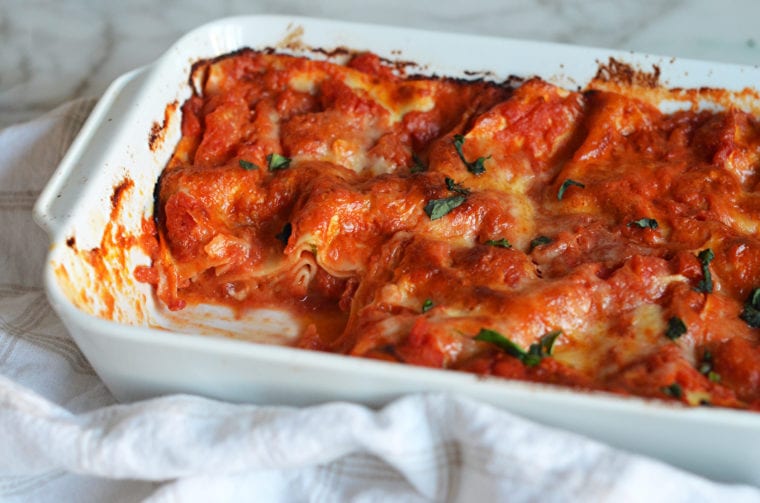
This lasagna comes from Julia Turshen’s lovely cookbook, Small Victories: Recipes, Advice + Hundreds of Ideas for Home Cooking Triumphs (Chronicle Books, 2016). Not only is it the simplest lasagna I’ve ever made, it’s also the lightest and most elegant. Julia writes that there are three “small victories” with the recipe. The first is using a food processor to make an easy homemade pasta dough (although I would argue that an even bigger victory is that you can replace the homemade pasta with store-bought no-boil lasagna noodles, which I did).
The second small victory is skipping both the American tradition of using ricotta and the Italian tradition of adding béchamel. Instead, Julia adds crème fraîche directly to the tomato sauce, which lends the requisite creaminess that all great lasagnas have, but with zero effort. (I LOVED this cheat. The sauce was so delicious, I had to stop myself from sneaking spoonfuls while assembling the lasagna, lest I run short.)
Finally, the third small victory is a high sauce-to-pasta ratio, which eliminates the step of having to cook the noodles before assembling the lasagna — and also allows the noodles to absorb the flavor of the sauce as they cook in the pan.
What you’ll need To Make Julia’s “Nice Lasagna”

Step-by-Step Instructions
Begin with the sauce. In a large bowl, crush the tomatoes with your hands.
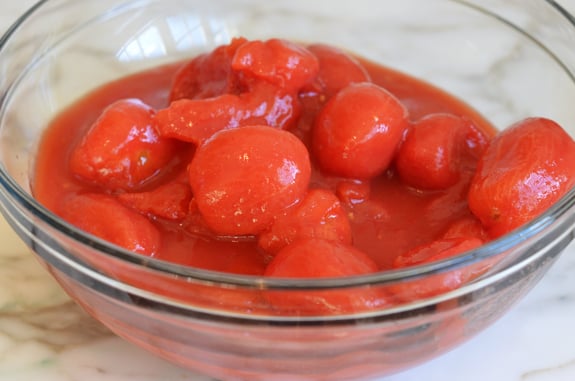
Julia suggests this as a good job for kids — I agree, although it’s messy so you might want to put the bowl in the sink.
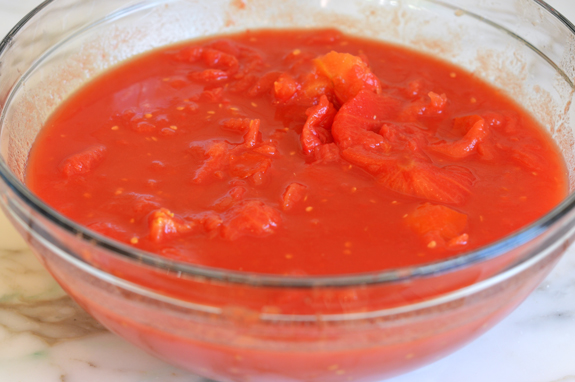
In a large saucepan, warm the olive oil. Add the garlic and cook until it begins to sizzle, about 1 minute.
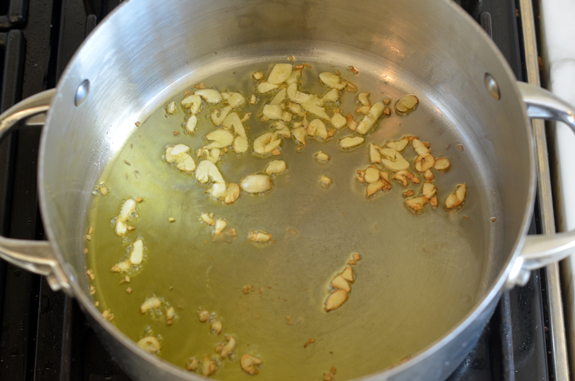
Add the tomatoes and salt and bring to a boil.
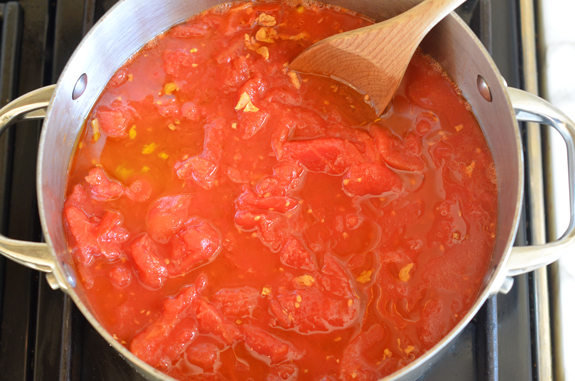
Lower the heat and let the sauce simmer, stirring every so often, until it’s slightly reduced, about 30 minutes.
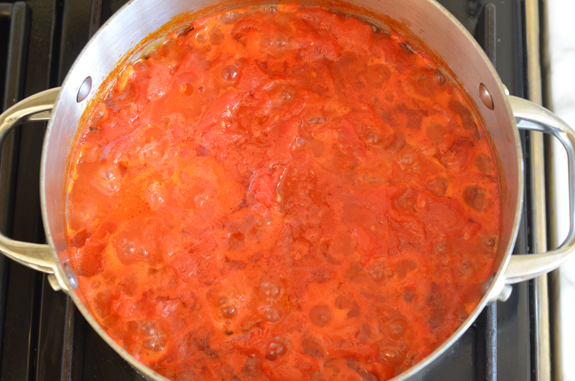
Mix in the crème fraîche.
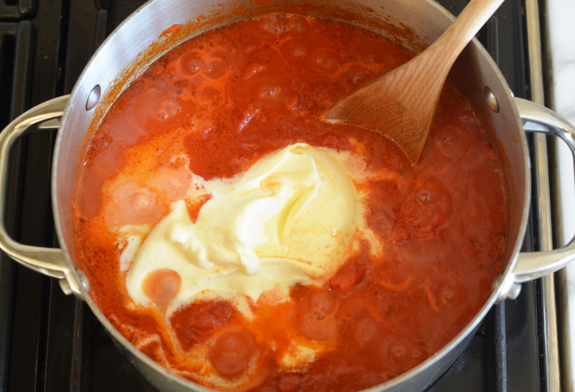
Season to taste with salt and set aside.
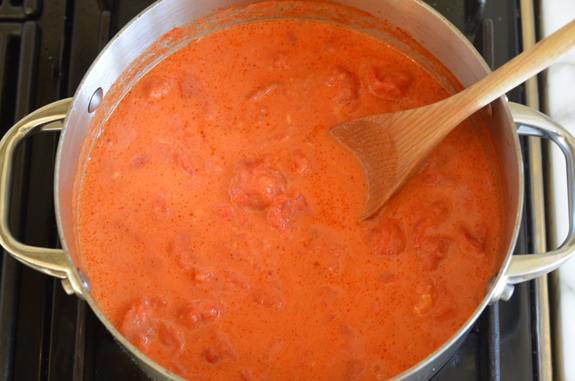
Next, assemble the lasagna. Ladle a thin layer of sauce onto the bottom of a baking dish. Spread the sauce to cover the surface of the dish, then add a layer of pasta over top.
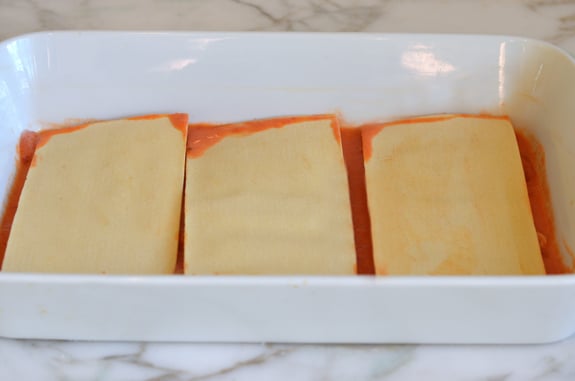
Spoon over just enough tomato sauce to cover the pasta and then scatter over some of the Parmesan, mozzarella, and basil.
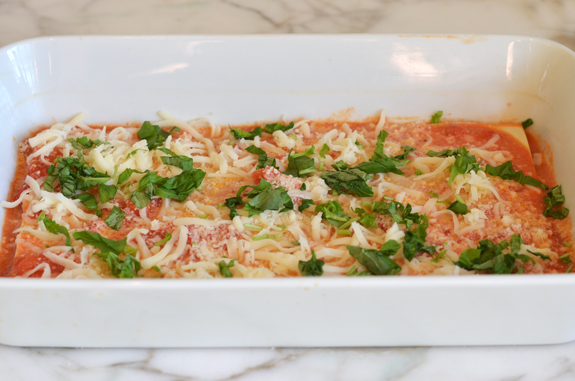
Repeat the layering process until you’ve used up all of your components, ending with sauce and cheese (not naked pasta or basil, both of which would burn if exposed).
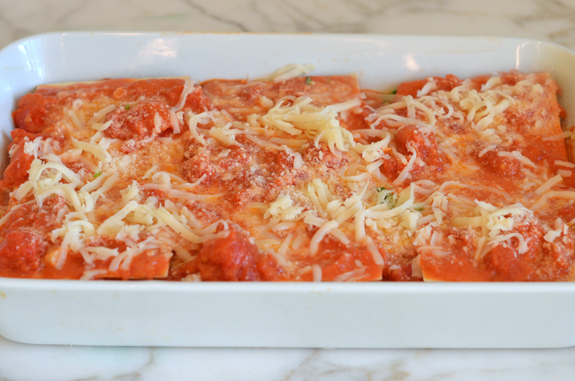
Bake the lasagna, uncovered, until it’s nicely browned and the edges are bubbling, 35 to 40 minutes.
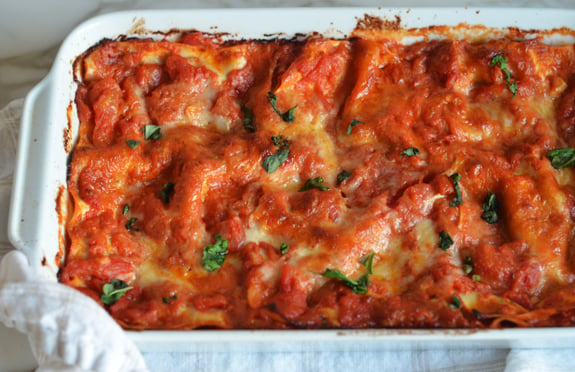
Let it rest at room temperature for 15 minutes to allow the pasta fully absorb all of the bubbling sauce, so you don’t end up with soupy slices.
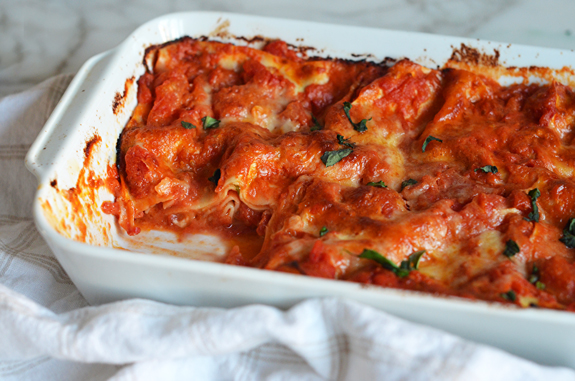
You may also like
- Sausage Lasagna
- Cheesy Stuffed Shells
- Baked Ziti with Sausage
- Gail Simmons’ Epic Spaghetti Pie
- Penne alla Vodka
- Spinach Manicotti
Julia Turshen's Lasagna
This light and elegant lasagna comes from Julia Turshen’s lovely cookbook, Small Victories (Chronicle Books, 2016).
Ingredients
For the Sauce
- Two 28-oz cans whole peeled tomatoes
- 3 tablespoons extra-virgin olive oil
- 4 garlic cloves, thinly sliced
- Kosher salt
- 1 cup crème fraîche
For the Pasta Dough (see note)
- 2¼ cups all-purpose flour, plus more as needed
- 3 eggs
- 1 teaspoon kosher salt
For Assembling
- 1 cup finely grated Parmesan Cheese
- 1½ cups coarsely grated whole-milk mozzarella cheese
- 2 large handfuls fresh basil leaves, torn into small pieces if large
Instructions
For the Sauce
- In a large bowl, crush the tomatoes with your hands (this is a messy but fun job—it’s a very good one for children) until they are in bite-size pieces.
- In a large saucepan over medium-high heat, warm the olive oil, add the garlic, and cook, stirring, until it begins to sizzle, about 1 minute. Add the tomatoes and 1 tsp salt and bring to a boil. Lower the heat and let the sauce simmer, stirring every so often, until it is slightly reduced, about 30 minutes.
- Whisk the crème fraîche into the sauce and season to taste with salt. Set the sauce aside to cool to room temperature while you conquer the pasta.
For the Pasta (See note about using store-bought noodles)
- In the bowl of a food processor, combine the flour, eggs and salt and run the machine until a firm ball of dough forms around the blade, cleans the side of the processor bowl, and doesn’t stick to your fingers when you touch it. If the dough is too dry, add a little water, 1 tsp at a time, until the dough comes together. If, on the other hand, it’s sticky when you touch it, add a little flour, 1 tsp at a time, until the dough comes together. (The exact amount of moisture in the dough depends on how you measured your flour, how large your eggs are, even the humidity in the air.) Once your dough is good to go, dust it lightly with flour and wrap it tightly in plastic wrap. Let it rest at room temperature for 1 hour.
- Line a baking sheet with parchment paper and have more parchment paper at hand.
- Cut the rested dough into six pieces. Working with one piece at a time (keep the rest covered with plastic), lightly dust the dough with flour and press it down with the heel of your hand. Run the dough through your pasta machine, starting on the widest setting and working your way through the narrower settings, rolling it through each setting twice, until it is very thin but not too thin. I usually stop at 6, but your machine might be different from mine, so I’ll just say that the final pasta should be the thickness of an envelope—which is to say thin, but not at all transparent. You don’t want it to disappear into the finished lasagna. If the dough sticks during the rolling, simply dust it with a little flour. Lay the rolled-out pasta on the prepared baking sheet. Repeat the process with the rest of the dough, keeping the rolled pieces separated with parchment paper.
For the Lasagna
- Preheat your oven to 400°F.
- Ladle a thin layer of room-temperature sauce onto the bottom of a 9-by-13-in baking dish. Spread the sauce with a spoon to cover the surface of the dish. Add a layer of pasta (brush off any excess flour), cutting the pasta and arranging it as needed to form an even single layer. Spoon over just enough tomato sauce to cover the pasta and then scatter over some of the Parmesan, mozzarella, and basil. Repeat the layering process until you’ve used up all of your components, ending with sauce and cheese (not naked pasta or basil, both of which would burn if exposed).
- Bake the lasagna, uncovered, until it’s gorgeously browned and the edges are bubbling, 35 to 40 minutes. Let it rest at room temperature for 15 minutes, just like you would a steak, before slicing and serving. This lets the pasta fully absorb all of the bubbling sauce, so you don’t end up with soupy slices.
- Note: Feel free to skip the homemade pasta and use 12 store-bought no-boil lasagna noodles (that's what I did and it worked beautifully). Please keep in mind that there are usually more than 12 lasagna noodles in a package. Make sure just to use 12; if not the dish will be very dry. The time given for this recipe was calculated using the store-bought noodles. If you use no-boil lasagna noodles, after you've prepared the sauce, you can move on to the next step without waiting for the sauce to cool.
- Note: My only change to the recipe, other than using no-boil lasagna noodles was to sprinkle fresh basil over top before serving.
Pair with
Nutrition Information
Powered by ![]()
- Per serving (8 servings)
- Calories: 390
- Fat: 20g
- Saturated fat: 9g
- Carbohydrates: 37g
- Sugar: 7g
- Fiber: 5g
- Protein: 17g
- Sodium: 711mg
- Cholesterol: 41mg
This website is written and produced for informational purposes only. I am not a certified nutritionist and the nutritional data on this site has not been evaluated or approved by a nutritionist or the Food and Drug Administration. Nutritional information is offered as a courtesy and should not be construed as a guarantee. The data is calculated through an online nutritional calculator, Edamam.com. Although I do my best to provide accurate nutritional information, these figures should be considered estimates only. Varying factors such as product types or brands purchased, natural fluctuations in fresh produce, and the way ingredients are processed change the effective nutritional information in any given recipe. Furthermore, different online calculators provide different results depending on their own nutrition fact sources and algorithms. To obtain the most accurate nutritional information in a given recipe, you should calculate the nutritional information with the actual ingredients used in your recipe, using your preferred nutrition calculator.

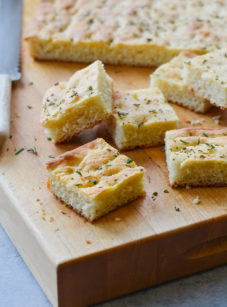
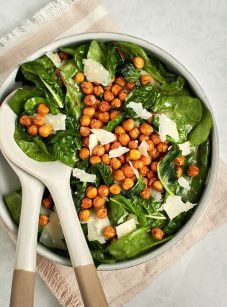

Howdy Jenn,
I live in western Pa., near Pittsburgh. My next door neighbor was an older Italian
woman that made the most amazingly light lasagna. I went looking for a similar recipe. This recipe nailed it. I don’t think she used creme fraiche, but what an awesome addition. Since finding this recipe we have made it a half dozen times. We do add a bit more garlic and cheese and use cream cheese instead of creme fresh as it wasn’t available nearby. Just took the sauce off the heat before whisking in. After seeing you use oven ready noodles I will never boil them again, just as good, and so mush easier. Thanks for an awesome recipe.
One of my favorite dishes to make and eat. I do cheat sometimes by using dried Basil instead of fresh. Not as good but in a pinch works. One of those dishes that you can always have items on hand in pantry.
This is hands down the best lasagna I have ever had! Plus, it is simple to make!
I would like to make this delicious lasagna but would like to add cooked spinach and sautéed mushrooms to it. Would I just add these 2 ingredients to the red sauce? Sandra
Hi Sandra, In the cookbook that the dish comes from, the author suggests evenly dividing any cooked veggies you’d like to use (like spinach or mushrooms) and adding them to each layer. Please LMK how it turns out!
This recipe is easy, the lasagna is creamy yet delightfully fresh tasting, and it doesn’t have the heaviness of the usual lasagna meal. I’m not a pasta fan but this has definitely become a favorite meal. Delicious!
Simple and delicious. This is in our regular rotation and never disappoints.
I’ve made this several times and it is fabulous. Simple and so good. Made my own creme fraiche. Also simple and so good. Would like to make this for a friend coming hime from hospital. Wondering if it can be frozen. If so, before or after baking?
So glad you like it! I prefer to freeze lasagna unbaked — it holds up better — but it’s fine to freeze a baked lasagna, too. Hope your friend enjoys!
My son, home from college, and I made this lasagna during the holidays season. It came together beautifully and tasted delicious. With some French bread and a salad, it was the perfect Sunday meal. The best part, though, is the memory of cooking together.
This is an easy recipe resulting in a lovely, light lasagna. I have made it many times.
This is my new go to recipe for lasagna! So much less work than my previous veggie lasagna. The creme fraiche in the sauce is genius. I added thinly sliced zucchini between the layers for some extra veg and served with simple green salad. YUMMO